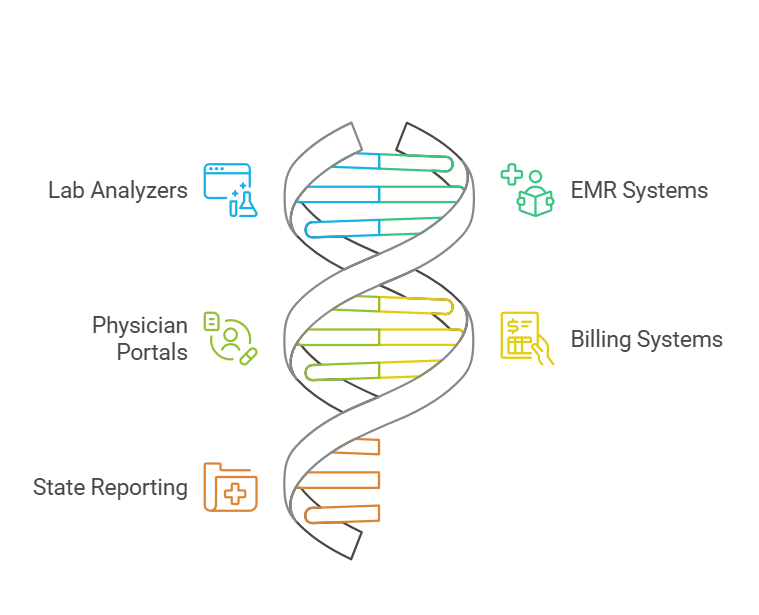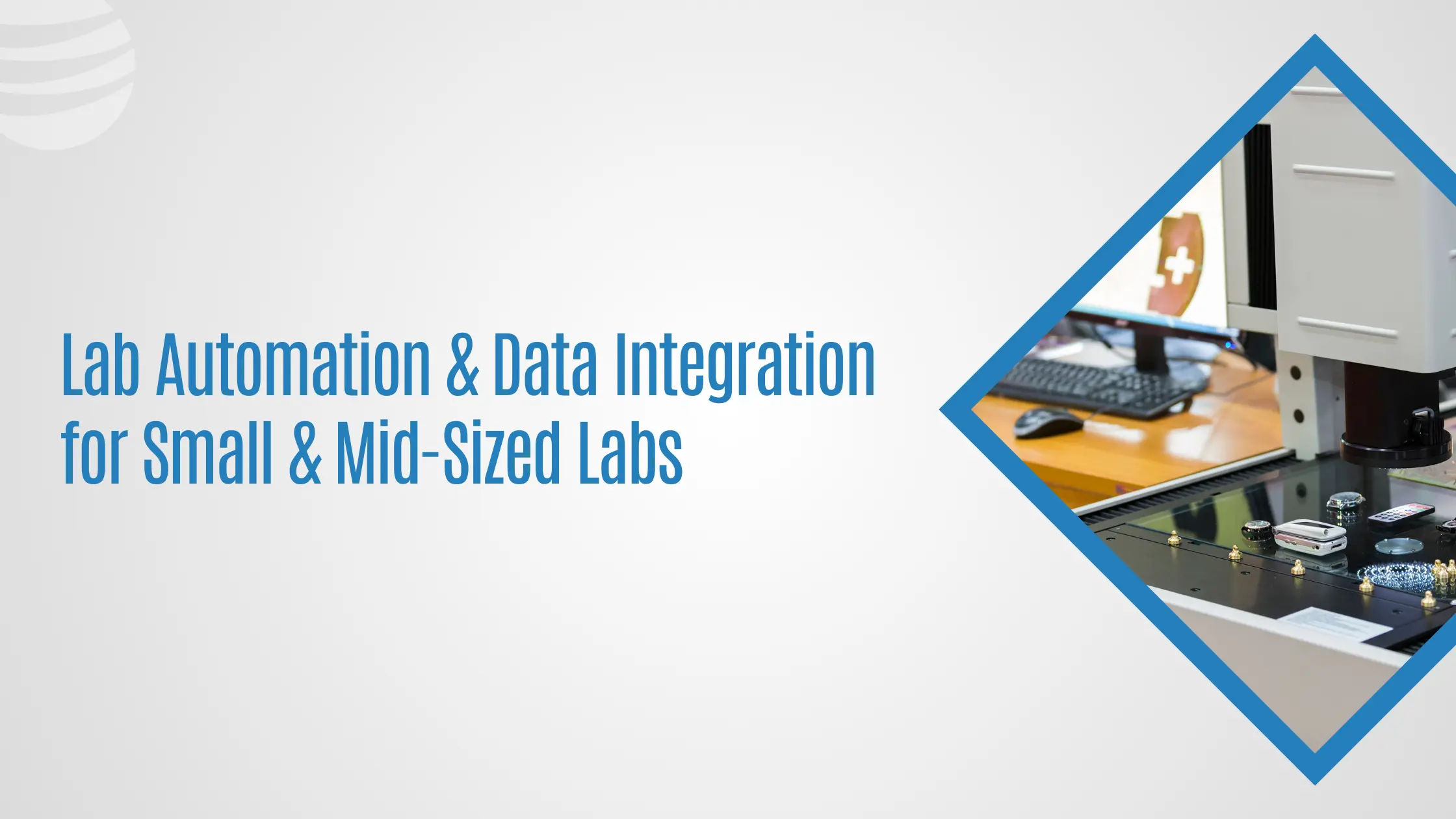
Laboratory Information System (LIS) Integration Challenges and Solutions
Laboratory Information Systems (LIS) play a crucial role in modern laboratory operations by streamlining workflows, enhancing accuracy, and supporting regulatory compliance. However, LIS integration presents unique challenges that laboratories must overcome to achieve seamless data flow, efficient operations, and high-quality patient care. This revamped blog will focus on key aspects of LIS integration, including common types of integrations, data compatibility, industry standards, and the essential role of stakeholder collaboration.
Most Common Types of LIS Integrations

1. Lab Analyzers and Instruments
LIS integration with lab analyzers and instruments automates the collection and reporting of test results. This eliminates manual data entry, reduces errors, and accelerates turnaround times. These integrations support devices such as:
Hematology analyzers
Chemistry analyzers
Immunology instruments
Molecular diagnostic devices
2. Electronic Medical Records (EMR) Systems
EMR-to-LIS integration allows for seamless exchange of orders and results. Physicians can place orders directly from the EMR and receive real-time test results within the same platform, fostering better coordination of patient care.
3. Physician Portals
Physician portals facilitate direct access to LIS for test order placement and result retrieval. This convenience enables healthcare providers to track lab progress and results in real time, improving service delivery.
4. Third-Party Billing Systems
For laboratories that do not have an in-house Revenue Cycle Management (RCM) module, LIS can integrate with third-party billing systems. This integration ensures the automatic transfer of billing data, streamlining invoicing and reducing administrative burdens.
5. State Reporting Systems
Many states require reporting of specific tests, such as COVID-19 results, to health authorities. LIS integrations with state reporting systems ensure regulatory compliance by automating the data submission process. This capability reduces manual intervention and prevents delays in reporting.
6. Reference Lab Integration
LIS-to-reference lab integrations streamline the handling of send-out tests. When a laboratory sends a test to an external reference lab, the integration ensures that order details and test results are automatically shared, eliminating manual entry and tracking.

Data Compatibility and Communication Standards

Effective LIS integrations rely on standardized protocols to ensure seamless data exchange between different systems. The most widely used standard is HL7 (Health Level 7), a set of international standards for the transfer of clinical and administrative data. HL7 protocols support the transfer of patient information, test orders, and results between LIS, EMR, and other systems. HL7 ensures that disparate systems "speak the same language," enabling interoperability across different platforms. Data Formats and Structures In addition to HL7, LIS integrations may involve other structured data formats such as CSV, XML, and JSON. Ensuring compatibility across these formats is essential for smooth data exchange.
LIS and Lab Analyzer Communication

LIS providers facilitate communication between laboratory analyzers and the LIS by leveraging specialized interfaces. This communication allows test results to flow from the analyzer directly into the LIS in real-time. Providers follow HL7 standards to develop these interfaces, ensuring compatibility with different instrument types.
Interface Types for Lab Analyzers
| Interface Type | Description | Example Use Case |
|---|---|---|
| Network-Based | Connects laboratory analyzers to the LIS system using a Local Area Network (LAN), enabling real-time data transfer and immediate access to results. | Used in modern clinical laboratories for efficient, high-speed connectivity. |
| Serial-Based | Uses a serial connection to link analyzers to the LIS system, typically for older analyzers lacking network capabilities. | Connecting legacy laboratory devices to the LIS system. |
| File-Based | Transfers data in the form of files (e.g., HL7, ASTM) from the analyzer to the LIS system for processing. | Used with non-standard analyzers or instruments that cannot be connected through network or serial interfaces. |
A File-Based Uni-Directional Interface involves the analyzer generating and sending result files directly to the Laboratory Information System (LIS) without receiving any input or acknowledgment from the LIS. This simple, one-way communication method is often used in systems where real-time feedback or dynamic interaction is not required. Serial Connection Interfaces operate over a direct wired connection. A Uni-Directional Serial Interface allows data to flow in only one direction from the analyzer to the LIS, typically for sending test results. In contrast, a Bi-Directional Serial Interface facilitates two-way communication, allowing not only the transmission of results but also the receipt of test orders from the LIS to the analyzer, supporting more dynamic interaction and control. Network Connection Interfaces utilize network protocols to transmit data. A Uni-Directional Network Interface operates similarly to its serial counterpart, sending test results from the analyzer to the LIS without feedback. On the other hand, a Bi-Directional Network Interface allows for full two-way communication over a network. This configuration supports real-time exchange of data, enabling the LIS to send test orders directly to the analyzer and receive test results in return, promoting efficiency and automation in laboratory workflows.
EMR and HL7 Interfaces

EMR and HL7 Interfaces facilitate seamless communication between the Laboratory Information System (LIS) and the Electronic Medical Record (EMR) system, streamlining laboratory workflows and supporting clinical decision-making. An HL7 Bi-Directional EMR Interface allows for real-time, two-way data exchange between the LIS and EMR. Physicians can place test orders directly from the EMR, and once the tests are completed, the results are automatically transmitted back to the EMR, enabling faster clinical decisions and reducing manual intervention. In contrast, an HL7 Uni-Directional EMR Interface only allows for one-way communication, where the LIS sends test results to the EMR, but test orders must be placed manually or through a separate system. This model is often used when the LIS lacks the capability to receive orders from the EMR. Additionally, an HL7 State Regulatory Interface enables automated reporting of communicable diseases, such as COVID-19, to state health departments. This interface ensures compliance with public health mandates and supports timely disease surveillance and reporting, which is crucial during outbreaks and public health emergencies.
LIS-to-Reference Lab Integrations

Laboratories that send tests to external reference labs require seamless LIS integration to avoid manual intervention. These integrations ensure that all order information is electronically shared with the reference lab, and test results are received automatically. This approach reduces the risk of errors, shortens processing times, and improves operational efficiency.
Importance of Stakeholder Collaboration

Successful LIS integrations require effective communication between key stakeholders, including:
Laboratory Teams: Define requirements, oversee system changes, and ensure data accuracy.
LIS Providers: Develop interfaces, configure integrations, and ensure compliance with HL7 and other standards.
Instrument Vendors: Provide technical details and support for instrument compatibility with LIS systems.
EMR Vendors: Collaborate on HL7 interface development to facilitate seamless integration.
Proactive communication and early involvement of stakeholders at each stage of the integration process help prevent delays, reduce costs, and ensure successful implementation. Stakeholders should schedule regular progress meetings, address issues in real time, and maintain a clear roadmap of integration milestones.
LIS integration is a multifaceted process that requires coordination across multiple systems, standards, and stakeholders. From integrating lab analyzers and EMRs to handling third-party billing, reference labs, and state reporting, each integration plays a role in enhancing laboratory efficiency and patient care. By leveraging industry standards like HL7, working with experienced LIS providers, and fostering collaboration with key stakeholders, laboratories can overcome integration challenges and achieve a fully connected system. With the right approach, LIS integration becomes a powerful driver of operational excellence, regulatory compliance, and superior patient outcomes.
FAQs (Frequently Asked Questions)
How do LIS integration challenges affect laboratories?
What are the key benefits of LIS integration?
How can cost challenges in LIS integration be mitigated?
What is the role of standardization in LIS integration?
How do cloud-based solutions aid LIS integration?
Why is effective integration crucial in laboratories?
Recent Posts

Operational Pain Points in Lab Automation & Data Integration for Small & Mid-Sized Labs
Operational Pain Points in Lab Automation and Data Integration for Small & Mid-Sized Labs Small and mid-sized diagnostic and reference laboratories often operate under tight

Impact of Instrument Integration vs Manual Data Entry in Laboratories
Efficiency Gains with LIS Integration vs. Manual Processes Faster Turnaround & Throughput: Connecting instruments to a Laboratory Information System (LIS) eliminates duplicate manual entry and

Enhancing Laboratory Productivity with Advanced LIS Lab Software Features
Enhancing Laboratory Productivity with Advanced LIS Lab Software Features Laboratories are the backbone of modern healthcare and research, providing critical insights for diagnostics, treatment, and
